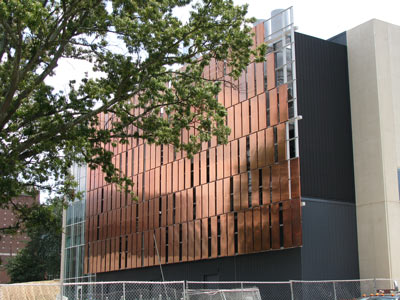No Mystery to Copper-clad Exterior For New GA Nanotechnology Center
Hidden message in "floating panel" design debunked
Maybe it was the building's exotic title - the new Nanotechnology Research Center on the Georgia Institute of Technology campus - that caused rumors about its unique exterior design to run a bit wild.
A series of individual copper panels, spaced in an organized yet curiously random fashion, seemed to float just off the face of the structure, screening the façade. As construction proceeded, "sidewalk superintendents" offered up any number of theories.
 Photo taken during construction by copper panel installer Harmon Inc.
Photo taken during construction by copper panel installer Harmon Inc. High-resolution version of this photo.
Was there a subliminal message hidden in the pattern, something related to the Center's purpose? A DNA sequence, perhaps? Or did the rectangular copper shapes imply "test strips," like those used in metallurgy labs?
Sorry, sci-fi fans. While the pattern may be mesmerizing, and fascinating to speculate on, sometimes a cigar is just a cigar.
"The screen was created because the building was a blank-walled structure," according to Joe Bridy of Bohlin Cywinski Jackson, the Pittsburgh-based architectural firm that designed the structure with international design firm M+W Zander.
The floating screen "helps to unify what are really two buildings separated by a long, linear gallery. Screening off the structure also should help the cooling load," a significant factor during hot Georgia summers, Bridy explained.
Architect David Murray of BCJ found the theories amusing. The random panel theme "just came out of our design proposal," he said. "We set up a 'spacing module' and placed the panels every eight, sixteen and twenty-four inches. Copper was selected as a beautiful material that would enhance the campus area adjacent to the building. It's obvious that we like copper-it's a natural material and it weathers nicely."
Although the 790 individual copper panels in the screen were as bright as new pennies when installed in 2008, the uncoated metal has already begun to oxidize and blend into its park-like surroundings. And while the building has energy-efficient features, including the panels, which contain 90 percent recycled copper content, Georgia Tech opted not to pursue LEED certification, Murray said.
The panels were fabricated of 48-ounce half-hard-temper solid copper, each measuring 32x101 inches. Perforations in the panel surfaces allow air to circulate through them to decrease their resistance to wind, which could tear them from their mounts during storms.
The panels and the hanger system that supports them were manufactured by LinEl Signature of Indianapolis, IN, a fabricator of architectural exteriors for such notable structures as the National Portrait Gallery in Washington, DC.
Andy Kireta Jr., vice president of building construction for the Copper Development Association, discussed the panel specifications with project officials early in the project.
"They were thinking of using 16-ounce perforated copper sheets," he recalled, "but that would have been too light for this application even if the sheets weren't perforated. For panels that size, the minimum you'd want is 32-ounce copper. Thanks to the heavier weight of these panels, you now see an amazing flatness across the face of the entire installation. I think they've done a super job." Cu
Also in this Issue:
- Las Vegas CityCenter a 'No Sweat' Building Project
- HVAC in a Bottle
- No Mystery to Copper-clad Exterior For New GA Nanotechnology Center
- Mankind's First Metal, Still Our Most Useful
- 2009 North American Copper in Architectural Awards Program Draws Numerous Entries
